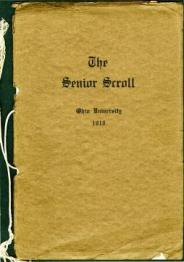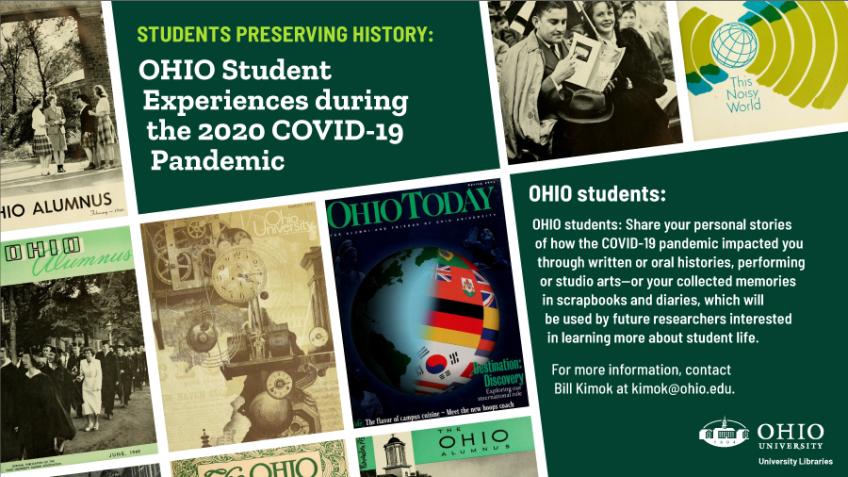
OHIO Libraries Preserving Student History during the Coronavirus
In the middle of an unsettling global turmoil stemming from the Covid-19 pandemic, University Libraries’ archivists began collecting personal stories from OHIO students about what it was like during the 2020 nationwide “lockdown.” Their intent: to record the impact of the epidemic on student life— before memories begin to fade.
These collected materials, which in themselves can be sources of healing, are being preserved and curated for the generation of researchers seeking knowledge about student reactions during this time period.
“What we are hoping to accomplish is to collect and archive a record that will be preserved for students, and anyone else, who wants to look at it in the future. There will potentially be a lot of different teaching and research uses for these materials—and we want to be prepared,” explained Miriam Intrator, special collections librarian for the Mahn Center for Archives & Special Collections.
Archivists and librarians are encouraging submissions, which can be uploaded in “Students Preserving History,” by the diverse voices of OHIO’s students that may include written, audio and video materials encompassing formats like written and oral histories, performing and studio arts and collected memories in scrapbooks and personal diaries.
“Students seldom think of themselves as being historic, because they are only here for four years, and then they are gone,” said Bill Kimok.
As University archivist and records manager, Kimok is responsible for collecting, preserving and making accessible the corporate memory of the University. These materials—which date back to the 1700s, encompass a broad spectrum of University-affiliated activities such as the presidents’ papers; Board of Trustees and Faculty Senate meetings; and student newspapers, scrapbooks, sports materials and much more—are all available to researchers who want to learn more about the history of the University.
Even before this crisis, Kimok had a hard time getting students to realize that, “Hey, we would like to have your scrapbooks,” and other student-collected materials about your time at OHIO.
So, he understands first-hand how frustrating it can be for researchers when information is missing from the University’s corporate memory, such as a very similar epidemic that plagued the world—the influenza pandemic.
“Actually, the problem is that there is not much at all—if anything—related to the 1918 pandemic,” said Kimok. “It has frustrated me that I have not been able to go into the archives and pull out materials on how the students reacted to the influenza epidemic.”
When the influenza epidemic hit, 102 years ago, no one really understood how to deal with a contagious virus that just hit all of a sudden and then moved quickly through environments where people meet in close quarters.

“There was not a [1918] yearbook that year, just a small tiny booklet (pictured here)—also, probably, because World War I was going on at the time. But, there was nothing in the way of student reactions,” said Kimok.
According to Intrator, the idea for the student-collected works percolated while attending webinars for curators of rare books and archives, where she started hearing how other institutions were doing similar projects. She subsequently reached out to her colleagues, who were also toying with similar ideas.
“I thought, it made a lot of sense,” she said. “And, I know how passionate Bill [Kimok] is about recording and preserving student experiences.”
The Students Preserving History project is strictly a collection of student work. While over time, many collections will arise from the University’s recorded history from this time period—such as administrative papers, presidents’ papers and the like—those materials will be separate from the student collection, which will offer the researcher a very different perspective.
Although gathering, organizing and preserving information is what OHIO librarians and archivists do well, creating a new digital collection, with no deadline in sight for accepting new materials, is no small feat—even for professionals who handle the technical components.
“I monitor the submitted forms, download the files, add the metadata, name the files appropriately, drop them into the Libraries’ digital storage and track all submissions in a spreadsheet,” explained Janet Carleton, digital initiatives coordinator. “Then I will be tasked with preserving these materials and creating an open digital collection.”
All to ensure that the collection is discoverable worldwide.
Although the project is still in its infancy stage, the responses from students are poignant and, for some, very emotional.
According to Kimok, recent student responses include a creative collaboration from three Honors Tutorial students, which was part of a classroom project, where each wrote and performed a song; choreographed and performed a short dance; and then submitted visual artwork.
Other submissions include journal-type essays, one from two seniors disappointed to have missed the end-of-the-year graduation celebrations; a student studying abroad who was quarantined in Spain; and one of the Libraries’ student employees, who recorded weekly observations, and wrote, “Life now is like the movie, ‘Groundhog Day.’”
The Libraries is looking forward to receiving more student submissions about what it was like during the 2020 nationwide “lockdown.” Please help us document the history of the University by submitting your student story here.
“They are not being graded; they are not being judged,” said Intrator. “They are [being collected] just for their informational content and historical significance.”
“I am very grateful to the Libraries’ staff for their collaboration in the launch of this important initiative, and to the students who are and will be contributing to it,” said Neil Romanosky, dean of University Libraries. “It is wonderful to be able to preserve and share, for years to come, the experiences of OHIO students during this singular moment in our history.”
Be sure to stay tuned for other news stories coming your way highlighting some of those student submissions.
For more information, contact Bill Kimok.
